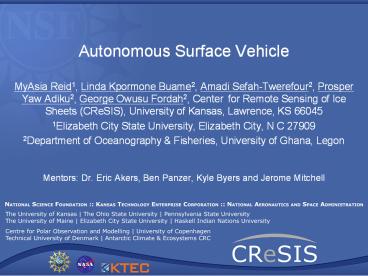Autonomous Surface Vehicle PowerPoint PPT Presentation
Title: Autonomous Surface Vehicle
1
Autonomous Surface Vehicle
- MyAsia Reid1, Linda Kpormone Buame2, Amadi
Sefah-Twerefour2, Prosper Yaw Adiku2, George
Owusu Fordah2, Center for Remote Sensing of Ice
Sheets (CReSIS), University of Kansas, Lawrence,
KS 66045 - 1Elizabeth City State University, Elizabeth City,
N C 27909 - 2Department of Oceanography Fisheries,
University of Ghana, Legon - Mentors Dr. Eric Akers, Ben Panzer, Kyle Byers
and Jerome Mitchell
2
OUTLINE
- Introduction
- Methodology
- Results
- Conclusion
- References
3
Introduction
- The response of organisms to changes in water
quality parameters enhances our understanding of
aquatic environment (Abowei, 2009). - MODIS) and SeaWIFs, are limited by assumption of
uniformity in pixels (Yuan et al, 2005). Designs
limited to open oceans - Insufficient sampling,
- Inaccuracy of geophysical corrections.
- Sampling can be augmented by using more than one
mission (Bouffard et al, 2008)
http//www.alticore.eu/
Dunbabin et al, 2009
4
Design considerations
- Drag depends on size, shape speed force due to
drag - (F) 0.5rhoV²CdA, lowest Cd is the best
- F is proportional to speed, gtspeed needs more
thrust and a greater drain on power.
5
Methodology
- Design components
- Microcontroller (Atmega 328)
- Motor controllers (10A brushed)
- Breadboard
- SD Card Reader
- GPS
- -shield (09487)
- -module (EM 406)
- Temperature Sensors (LM335a)
- Batteries(12V/8Ah , 12V/18Ah)
6
Design
- ASV flowchart.
7
Final design of ASV
On land
In the workshop
8
Arduino
- What is an Arduino?
- is a single-board microcontroller and a software
suite for programming it. The software consists
of a standard programming language and the boot
loader that runs on the board. - Microcontroller The hardware consists of a
simple open hardware design for the controller
with an Atmel AVR processor and on-board I/O
support.
9
Temperature sensor
- Analog temperature sensor
- Works like a Zener diode
- Calibrated at 25C at and 5V input voltage and a
2.982V output
LM335A
10
Navigation and Control (GPS)
- GPS Bearing.
- Satellite based navigation system.
- Based on the network of 24 satellites.
- GPS intended for military use, but available for
civilian use in the 1980s. - Works off satellite, tracking positions of
locations. - For direction, tracking and navigation.
www.diytrade.com
www.vialite.co.uk
www.rei.com
www.navigadget.com
11
- Credit http//forums.garmin.com
12
GPS-09487
GPS Shield
Connector Vertical SMD for EM408
Coin Cell Holder - 12mm
20 Channel EM-406A SiRF III Receiver with Antenna
EM 406
Credit http//www.sparkfun.com/
13
Bearing calculations..
- Bearing calculations done in radians
- Bearing (x)
- atan2(sin(lon2-lon1)cos(lat2),cos(lat1)sin(lat2
))sin(lat1)cos(lat2)cos(lon2-lon1))- - degreesx 180/M_PI (M_PI is the constant from
math.h set for value of PI) - To ensure that it remains in proper range
- Degreesdegrees 360 if degrees is less than 0
http//drifters.doe.gov/track-a-yoto/tr
ack-a-drifter.html
14
Distance calculations
- Haversine distance calculations
- dlat lat2-lat1
- dlonlon2-lon1
- apow(sin(dlat/2),2)cos(lat1)pow(sin(dlon/2),2)
- c2atan2(sqrt(a),sqrt(1-a))
- Distance rc// radius of the earth in meters
- r 6378140m
Credit http//en.wikipedia.org/wiki/Haversine_for
mula
15
Results
16
ASV navigating on Clinton Lake
17
Conclusion
- An ASV that can navigate specific way point has
been built. - Future work would focus on increasing sensor
capacity by putting on board more sensors as well
as buoy mode and possibly obstacle avoidance.
18
Acknowledgements
- Thanks to
- Dr. Eric Akers
- Dr. Claude Laird
- Dennis Sundermeyer
- Leon Searl
- Ben Panzer
- Kyle Byers
- Jerome Mitchell
19
References
- Abowei, J.F.N (2010) Salinity, Dissolved Oxygen,
pH and Surface Water Temperature Conditions in
Nkoro River, Niger Delta, Nigeria, Advance
Journal of Food Science and Technology 2(1)
36-40, 2010 - Dunbabin, M., Alistair G. and J. Udy (2009) An
Autonomous Surface Vehicle for Water Quality
Monitoring Autonomous Systems Laboratory, CSIRO
ICT Centre, P.O. Box 883, Kenmore, QLD 4069,
Australia. - Get a bearing. Accessed from the world wide web
on 14th June,2010 at http//geaology.isu.edu/geost
ac/Fieldexercie/topomaps/bearing.html - Great circle.Accessed from the world wide web on
18th July 2010 at www.answers.com/topic/great_circ
le - Haversine formula. Accessed from the world wide
web on 8th July,2010 at www.absoluteastronomy.com/
topics/Haversine_formula - Haversine formula.Accessed from the world wide
web on 14th June 2010 at http//en.wikipedia.org/w
iki/Haversine_formula - J. Bouffard,1 S. Vignudelli,2 P. Cipollini,3 and
Y. Menard (2008) Exploiting the potential of an
improved multimission altimetric data set over
the coastal ocean. Geophysical research letters,
vol. 35, l10601, 2008 - Latitude and Longitude general information.
Accessed from the world wide web on 11th June
2010 at www.csgnetwork.com/latloninfo.html - Mathematicsltmath.hgt.Accessed from the world wide
web on 25th June,2010 at http//www.nongnu.org/avr
-libc/user-manual/group_avr_math.html - Rogue robotic online www.roguerobotics.com
20
(No Transcript)

